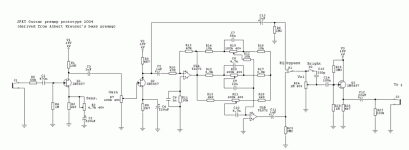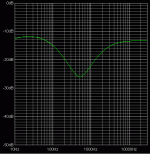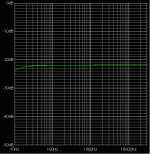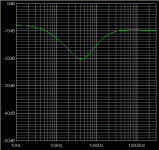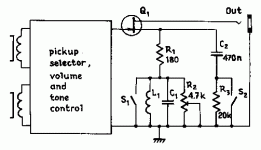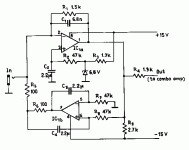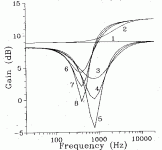HI Guys!
I'm putting together a JFET guitar amp at the moment. Got the idea from Albert Kreuzer's page about the FET preamp he made for bass.
Have a look and let me hear your comments.
PS: The JFET used in the circuit should be BF245 or 2N3819
Look here for schematic:
http://www.bossaboa.dk/preamp.gif
or
http://www.bossaboa.dk/preamp.pdf
Best,
- Peter
I'm putting together a JFET guitar amp at the moment. Got the idea from Albert Kreuzer's page about the FET preamp he made for bass.
Have a look and let me hear your comments.
PS: The JFET used in the circuit should be BF245 or 2N3819
Look here for schematic:
http://www.bossaboa.dk/preamp.gif
or
http://www.bossaboa.dk/preamp.pdf
Best,
- Peter
Updated schematic for FET guitar preamp.....
Updated schematic for FET guitar preamp:
I've made a few adjustments and eratas since the first version.
This preamp sounds great - forget about opamps for a moment a try this one. It's warm, smooth and tubey. Very simple circuit with few phase invertion stages.
Further ideas:
Effects loops
Spring reverb circuit
Overload/peak LED circuit
Parametric mid
Updated schematic for FET guitar preamp:
I've made a few adjustments and eratas since the first version.
This preamp sounds great - forget about opamps for a moment a try this one. It's warm, smooth and tubey. Very simple circuit with few phase invertion stages.
Further ideas:
Effects loops
Spring reverb circuit
Overload/peak LED circuit
Parametric mid
Attachments
I can suggest to you to increase R4, to decrease C1 (at least ten times). I also think it will be good to move "bright" switch to the input FET source. And as for me the Baxandall-type tone control suits better to "clean" channel, while in "distortion" channel the simple Fender tone control is OK. My suggestions cannot be applicable to you, as I don't know in what style do you perform.
HI Dimitri,
Increasing R4 is a bad idea IMHO. Normally for guitar amps you see a 1M resistor here.
From what I knough (I'm not ingenier;-) this means that the input will be as noisy as a 1M resistor (called thermal noise??), Right?
Maybe better to decrease the input impedance to 500K if you can, to get the noise down?
C1 is too big - I agree. On most circuits you see a 100n here together with a 1M going to earth. The lowest note on guitar is 84hZ so the filter has to cut below this.
Moving the brightfilter to the input FET is a good idea. But how and where would you do that? Any ideas?
For me the Baxandall-type EQ is the best for guitar - no matter what style I play.
I think that the Fender passive tonecontrol is a mistake and a result of bad design. Leo might have stolen it from and RCA book without giving it too much thought. Today it's just how we percieve a guitar to sound.....
You see, when you place the controls of a fender EQ at 12'oclock it's not neutral at all, but cutting your midrange at ca. 750Hz (look at the plot).
Good for twangy countrymusic but not good for more midrangy playing.
To get a flat frequenze response you have to set bass and treble at 0, and the mid all the way up (see picture 2). Still it's not the same sound as a Baxendale. Sounds out of phase to me....
If I need the Fender curve I just turn down the mid on the Baxendal and get the same result.
Yes, I'm building the FET preamp as a "Clean" channel. For distortion I put a box( or two;-) infront. I don't ever you the "Drive" channel for that simple reason that all the effects that I put in front will be distorted Fx. reverb and delay .
.
Unless you use a effects loop afer the drive channel ofcourse
This FET pre is going to be used with both electric and acoustic (godin) guitars, so it should have the possibily to play 99% clean if I want it to. The FET's will hopefully add a nice and warm tubey coloring....
- Peter
Increasing R4 is a bad idea IMHO. Normally for guitar amps you see a 1M resistor here.
From what I knough (I'm not ingenier;-) this means that the input will be as noisy as a 1M resistor (called thermal noise??), Right?
Maybe better to decrease the input impedance to 500K if you can, to get the noise down?
C1 is too big - I agree. On most circuits you see a 100n here together with a 1M going to earth. The lowest note on guitar is 84hZ so the filter has to cut below this.
Moving the brightfilter to the input FET is a good idea. But how and where would you do that? Any ideas?
For me the Baxandall-type EQ is the best for guitar - no matter what style I play.
I think that the Fender passive tonecontrol is a mistake and a result of bad design. Leo might have stolen it from and RCA book without giving it too much thought. Today it's just how we percieve a guitar to sound.....
You see, when you place the controls of a fender EQ at 12'oclock it's not neutral at all, but cutting your midrange at ca. 750Hz (look at the plot).
Good for twangy countrymusic but not good for more midrangy playing.
To get a flat frequenze response you have to set bass and treble at 0, and the mid all the way up (see picture 2). Still it's not the same sound as a Baxendale. Sounds out of phase to me....
If I need the Fender curve I just turn down the mid on the Baxendal and get the same result.
Yes, I'm building the FET preamp as a "Clean" channel. For distortion I put a box( or two;-) infront. I don't ever you the "Drive" channel for that simple reason that all the effects that I put in front will be distorted Fx. reverb and delay
 .
. Unless you use a effects loop afer the drive channel ofcourse
This FET pre is going to be used with both electric and acoustic (godin) guitars, so it should have the possibily to play 99% clean if I want it to. The FET's will hopefully add a nice and warm tubey coloring....
- Peter
Attachments
Here I have simulated the Fender "neutral" curve with a standard Baxendale with only a bass and treble control. Both are turned about 75% up.
On the downside you can say that the Baxendale actually gains the signal, where the Fender only takes from "whats there allready".
Using quality components I don't think that noise is a problem today.
- Peter
On the downside you can say that the Baxendale actually gains the signal, where the Fender only takes from "whats there allready".
Using quality components I don't think that noise is a problem today.
- Peter
Attachments
HI Peter,
Thank you for your comment, now I see you are a good company
>Increasing R4 is a bad idea IMHO. Normally for guitar amps you see a 1M resistor here.
>From what I knough (I'm not ingenier;-) this means that the input will be as noisy as a 1M resistor (called thermal noise??), Right?
>Maybe better to decrease the input impedance to 500K if you can, to get the noise down?
No, the input impedance is shunted by pickup resistance, inductance and capacitance, so the input resistor will give rather small contribution in the overall noise. From the other side the pickup inductance and capacitance (with the cable and input capacitance) form a parallel resonant circuit with frequency 2-10kHz. If you use 0.5MOhm input resistor the resonance is almost damped, but if you use 5MOhm input resistor you can obtain up to +12dB resonant peak – so called voice (this is a small secret) – you can play with different caps in the range 500pF-2.2nF and put them in parallel with input resistor. By the way the 68kOm in series with input cap is too high/noisy. Use 2.2-4.7kOhm
>C1 is too big - I agree. On most circuits you see a 100n here together with a 1M going to earth. The lowest note on guitar is 84hZ so the filter has to cut below this.
If you design clean channel – what you actually did – don’t change it. Whether would you like to design distortion channel make the high pass filter 500-1000Hz or so, thus the low-frequency notes will be attenuated before distortion and will not give unpleasant roar.
>Moving the brightfilter to the input FET is a good idea. But how and where would you do that? Any ideas?
Use 10-47nF instead of C2 – it will be bright and shunt it by switch with your 220uF – it will be normal.
>For me the Baxandall-type EQ is the best for guitar - no matter what style I play.
Yes, I agree, but the e-guitar is not the source when we can speak about flat frequency response. I omit EQ at all and use octave equalizer in effect loop after gain stages.
>Yes, I'm building the FET preamp as a "Clean" channel. For distortion I put a box( or two;-) infront. I don't ever you the "Drive" channel for that simple reason that all the effects that I put in front will be distorted Fx. reverb and delay .
Yes this is bad idea to put reverb and delay before combo, because not only the direct signal will be distorted, but reflection signal also and it will be a complete mess, use them in the effect insert/return connection _only_.
>Unless you use a effects loop afer the drive channel ofcourse
>This FET pre is going to be used with both electric and acoustic (godin) guitars, so it should have the possibily to play 99% clean if I want it to. The FET's will hopefully add a nice and warm tubey coloring....
Yes, it will …
Thank you for your comment, now I see you are a good company
>Increasing R4 is a bad idea IMHO. Normally for guitar amps you see a 1M resistor here.
>From what I knough (I'm not ingenier;-) this means that the input will be as noisy as a 1M resistor (called thermal noise??), Right?
>Maybe better to decrease the input impedance to 500K if you can, to get the noise down?
No, the input impedance is shunted by pickup resistance, inductance and capacitance, so the input resistor will give rather small contribution in the overall noise. From the other side the pickup inductance and capacitance (with the cable and input capacitance) form a parallel resonant circuit with frequency 2-10kHz. If you use 0.5MOhm input resistor the resonance is almost damped, but if you use 5MOhm input resistor you can obtain up to +12dB resonant peak – so called voice (this is a small secret) – you can play with different caps in the range 500pF-2.2nF and put them in parallel with input resistor. By the way the 68kOm in series with input cap is too high/noisy. Use 2.2-4.7kOhm
>C1 is too big - I agree. On most circuits you see a 100n here together with a 1M going to earth. The lowest note on guitar is 84hZ so the filter has to cut below this.
If you design clean channel – what you actually did – don’t change it. Whether would you like to design distortion channel make the high pass filter 500-1000Hz or so, thus the low-frequency notes will be attenuated before distortion and will not give unpleasant roar.
>Moving the brightfilter to the input FET is a good idea. But how and where would you do that? Any ideas?
Use 10-47nF instead of C2 – it will be bright and shunt it by switch with your 220uF – it will be normal.
>For me the Baxandall-type EQ is the best for guitar - no matter what style I play.
Yes, I agree, but the e-guitar is not the source when we can speak about flat frequency response. I omit EQ at all and use octave equalizer in effect loop after gain stages.
>Yes, I'm building the FET preamp as a "Clean" channel. For distortion I put a box( or two;-) infront. I don't ever you the "Drive" channel for that simple reason that all the effects that I put in front will be distorted Fx. reverb and delay .
Yes this is bad idea to put reverb and delay before combo, because not only the direct signal will be distorted, but reflection signal also and it will be a complete mess, use them in the effect insert/return connection _only_.
>Unless you use a effects loop afer the drive channel ofcourse
>This FET pre is going to be used with both electric and acoustic (godin) guitars, so it should have the possibily to play 99% clean if I want it to. The FET's will hopefully add a nice and warm tubey coloring....
Yes, it will …
You can find one of my active guitar electronics (active wire) on my page
www.angelfire.com/az3/dimitri/
and the figures of my other front-end electronics, which was published in ETI, 1995, June are below. May be somebody can help me to find this paper as my copy had gone with the hard drive to the trash can.
www.angelfire.com/az3/dimitri/
and the figures of my other front-end electronics, which was published in ETI, 1995, June are below. May be somebody can help me to find this paper as my copy had gone with the hard drive to the trash can.
Attachments
The program I used for the EQ curves are called Tone stack calculator found at http://www.duncanamps.com/tsc/
Great tool for trying all kinds of tonestack for guitar out.
Baxendale is there too - it's called "james".
- Peter
Great tool for trying all kinds of tonestack for guitar out.
Baxendale is there too - it's called "james".
- Peter
>I would like you to elaborate and explain a little on the two GIF's your have attached.
Could you please ask what is incomprehensible?
>Wouldnt it be easier just to move the bright cap and switch to the gain pot?
Yes you can do it, you will get different sonic signature, so you can try what would you like best. In my preamps frequently I use both “bright” switches: in the source(cathode) of the first stage and by bypassing of the “gain” pot.
I try to explain. The second stage, being JFET or tube based, will have a substantial input current when being overdriven by positive half of waveform. The capacitor C3 will be charged by this current through part of R7+R1 and move the working point of the second stage to the negative gate-source voltages. This effect can be described like a small compression or sustain. If you use “bright” by bypassing of the “gain” pot this compression/sustain will not be pronounceable at high frequencies.
Could you please ask what is incomprehensible?
>Wouldnt it be easier just to move the bright cap and switch to the gain pot?
Yes you can do it, you will get different sonic signature, so you can try what would you like best. In my preamps frequently I use both “bright” switches: in the source(cathode) of the first stage and by bypassing of the “gain” pot.
I try to explain. The second stage, being JFET or tube based, will have a substantial input current when being overdriven by positive half of waveform. The capacitor C3 will be charged by this current through part of R7+R1 and move the working point of the second stage to the negative gate-source voltages. This effect can be described like a small compression or sustain. If you use “bright” by bypassing of the “gain” pot this compression/sustain will not be pronounceable at high frequencies.
And Mr.Lund, on your site http://www.bossaboa.dk on the photo on the starting page – where are you – on the left? 
Dimitri,
I get the point about the different placement of the bright switch. I never thought about it this way. Very interesting. I'll try both exsamples to see what I like the best.
It seems that you have designed quite a few guitar preamps yourself. Would you like to share some of them?
- Peter
PS: What I really like about desiging for instruments is that it's all about sound - not measurements....
If it sounds right...it is right!
- Peter
I get the point about the different placement of the bright switch. I never thought about it this way. Very interesting. I'll try both exsamples to see what I like the best.
It seems that you have designed quite a few guitar preamps yourself. Would you like to share some of them?
- Peter
PS: What I really like about desiging for instruments is that it's all about sound - not measurements....
If it sounds right...it is right!
- Peter
The guitar amp must work in heavy conditions, say from +10C (club with bad heating) up to +60C (summer stage or when some stupid idiot put your amp on the top of tube combo  ). When you open datasheet for 2N5457, you can find that drain current changes ~ 20% in that temperature range. The sound of your amp will change with temperature. I show my design which is actually the same common source JFET stage, then i/v converter with servo, no need for temperature compensation and no caps.
). When you open datasheet for 2N5457, you can find that drain current changes ~ 20% in that temperature range. The sound of your amp will change with temperature. I show my design which is actually the same common source JFET stage, then i/v converter with servo, no need for temperature compensation and no caps.
- Status
- This old topic is closed. If you want to reopen this topic, contact a moderator using the "Report Post" button.
- Home
- Live Sound
- Instruments and Amps
- New JFET guitar preamp project
